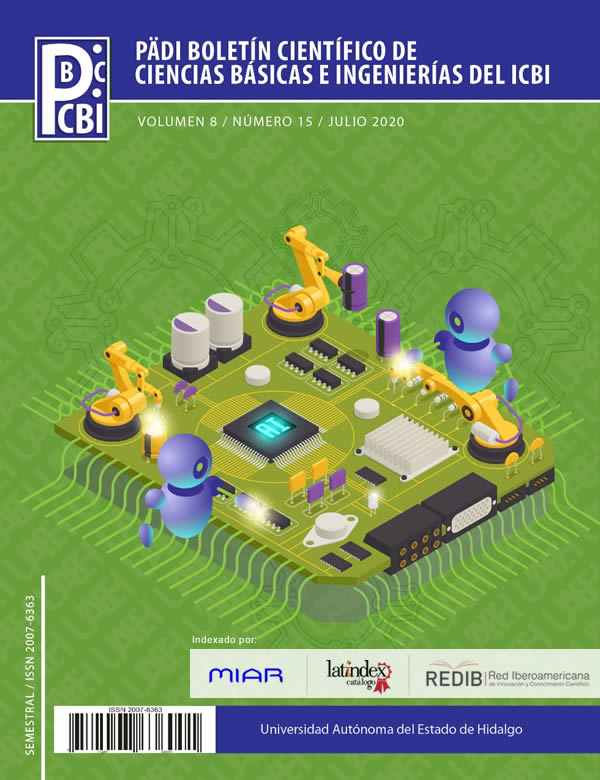Implementación de Controladores por Modos Deslizantes en un Convertidor Boost
DOI:
https://doi.org/10.29057/icbi.v8i15.5764Resumen
En este artículo se presenta la implementación de dos estrategias de control por modos deslizantes en un convertidor de potencia tipo Boost. Las estrategias escogidas son un modo deslizante convencionaly un Super Twisting saturado. El algoritmo de control continuo es embebido en una tarjeta de desarrollo y la señal generada es inyectada en el convertidor mediante el uso de un modulador Sigma-Delta analógico.
El controlador discontinuo se implementa analógicamente. Los algoritmos implementados aseguran la regulación de la corriente en los convertidores, aún cuando se presenten cambios no previstos en la carga del convertidor.
Descargas
Información de Publicación
Perfiles de revisores N/D
Declaraciones del autor
Indexado en
- Sociedad académica
- N/D
Citas
Aime, M., Gateau, G., & Meynard, T. (2007). Implementation of a peak-current-control algorithm within a field-programmable gate array. IEEE Transactions on Industrial Electronics, 54(1), 406–418. DOI: 10.1109/TIE.2006.885501
Alsmadi, Y. M., Utkin, V., Haj-ahmed, M. A., & Xu, L. (2018). Sliding mode control of power converters: DC/DC converters. International Journal of Control, 91(11), 2472–2493. URL: https://doi.org/10.1080/00207179.2017.1306112
Castillo, I., Steinberger, M., Fridman, L., Moreno, J., & Horn, M. (2016). Saturated super-twisting algorithm based on perturbation estimator. In: 2016 IEEE 55th Conference on Decision and Control (CDC) (pp. 7325–7328). DOI: 10.1109/CDC.2016.7799400
El Fadil, H., & Giri, F. (2007). Backstepping based control of PWM DC-DC boost power converters. In: 2007 IEEE International Symposium on Industrial Electronics (pp. 395–400). DOI: 10.1109/ISIE.2007.4374630
Hart, D. W. (2011). Power electronics (1st ed.). McGraw-Hill, New York. URL: https://www.mheducation.com/highered/product/power-electronics-hart/M9780073380674.html
Kazimierczuk, M. K., & Massarini, A. (1997). Feedforward control of DC-DC PWM boost converter. IEEE Transactions on Circuits and Systems I: Fundamental Theory and Applications, 44(2), 143–148. DOI: 10.1109/81.554332
Levant, A. (1993). Sliding order and sliding accuracy in sliding mode control. International Journal of Control, 58(6), 1247–1263. URL: https://doi.org/10.1080/00207179308923053
Levant, A. (1998). Robust exact differentiation via sliding mode technique. Automatica, 34(3), 379–384.
Mahdavi, J., Emadi, A., & Toliyat, H. A. (1997). Application of state space averaging method to sliding mode control of PWM DC/DC converters. In: IAS’97. Conference Record of the 1997 IEEE Industry Applications Conference Thirty-Second IAS Annual Meeting (Vol. 2, pp. 820–827). DOI: 10.1109/IAS.1997.628957
Mattavelli, P., Rossetto, L., & Spiazzi, G. (1997). Small-signal analysis of DC-DC converters with sliding mode control. IEEE Transactions on Power Electronics, 12(1), 96–102. DOI: 10.1109/63.554174
Mattavelli, P., Rossetto, L., Spiazzi, G., & Tenti, P. (1993). General-purpose sliding-mode controller for DC/DC converter applications. In: Proceedings of IEEE Power Electronics Specialist Conference - PESC ’93 (pp. 609–615). DOI: 10.1109/PESC.1993.471989
Middlebrook, R. D., & Cuk, S. (1976). A general unified approach to modelling switching-converter power stages. In: 1976 IEEE Power Electronics Specialists Conference (pp. 18–34). DOI: 10.1109/PESC.1976.7072895
Oucheriah, S., & Guo, L. (2013). PWM-based adaptive sliding-mode control for boost DC–DC converters. IEEE Transactions on Industrial Electronics, 60(8), 3291–3294. DOI: 10.1109/TIE.2012.2203769
Padmanaban, S., Grandi, G., Blaabjerg, F., Wheeler, P., Siano, P., & Hammami, M. (2017). A comprehensive analysis and hardware implementation of control strategies for high output voltage DC-DC boost power converter. International Journal of Computational Intelligence Systems, 10(1), 140–152. URL: http://eprints.nottingham.ac.uk/36925/ DOI: 10.2991/ijcis.2017.10.1.10
Reiss, J. (2008). Understanding sigma-delta modulation: The solved and unsolved issues. 56.
Seeber, R., & Horn, M. (2017). Stability proof for a well-established super-twisting parameter setting. Automatica, 84, 241–243. URL: http://www.sciencedirect.com/science/article/pii/S000510981730328X DOI: https://doi.org/10.1016/j.automatica.2017.07.002
Seeber, R., & Horn, M. (2019). Guaranteeing disturbance rejection and control signal continuity for the saturated super-twisting algorithm. IEEE Control Systems Letters, 3(3), 715–720. DOI: 10.1109/LCSYS.2019.2917054
Shtessel, Y., Edwards, C., Fridman, L., & Levant, A. (2014). Sliding Mode Control and Observation (1st ed.). Birkhäuser, New York, NY. DOI: https://doi.org/10.1007/978-0-8176-4893-0
Sira-Ramirez, H., & Ortega, R. (1995). Passivity-based controllers for the stabilization of DC-to-DC power converters. In: Proceedings of 1995 34th IEEE Conference on Decision and Control (Vol. 4, pp. 3471–3476). DOI: 10.1109/CDC.1995.479122
Sira-Ramirez, H., & Rios-Bolivar, M. (1994). Sliding mode control of DC-to-DC power converters via extended linearization. IEEE Transactions on Circuits and Systems I: Fundamental Theory and Applications, 41(10), 652–661. DOI: 10.1109/81.329725
Sira-Ramírez, H., & Silva-Ortigoza, R. (2006). Control Design Techniques in Power Electronics Devices (1st ed.). Springer, London. DOI: https://doi.org/10.1007/1-84628-459-7
Utkin, V. (2013). Sliding mode control of DC/DC converters. Journal of the Franklin Institute, 350(8), 2146–2165. URL: http://www.sciencedirect.com/science/article/pii/S0016003213000975 DOI: https://doi.org/10.1016/j.jfranklin.2013.02.026
Ventura, U. P., & Fridman, L. (2016). Chattering measurement in SMC and HOSMC. In: 2016 14th International Workshop on Variable Structure Systems (VSS) (pp. 108–113). DOI: 10.1109/VSS.2016.7506900




















